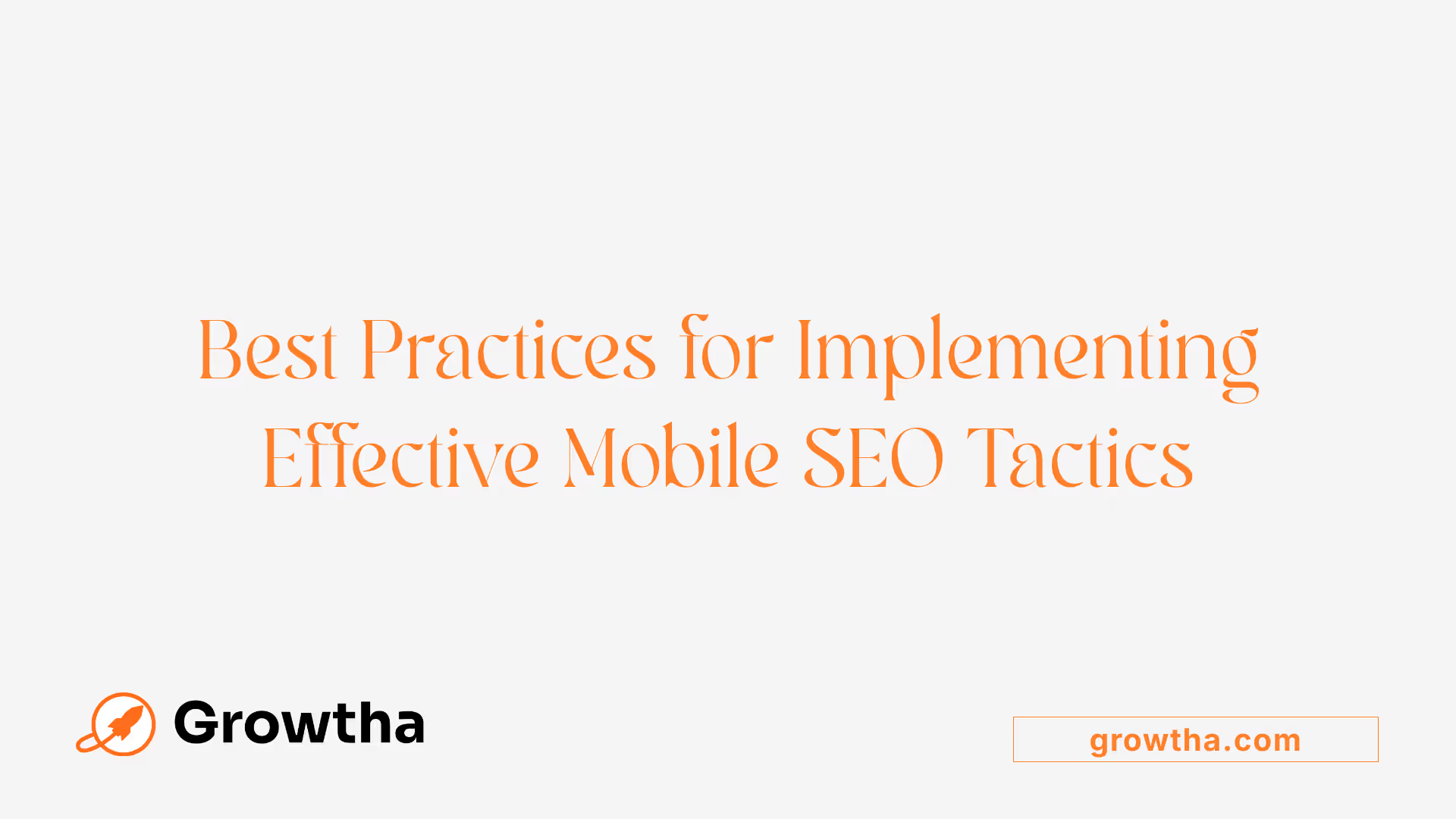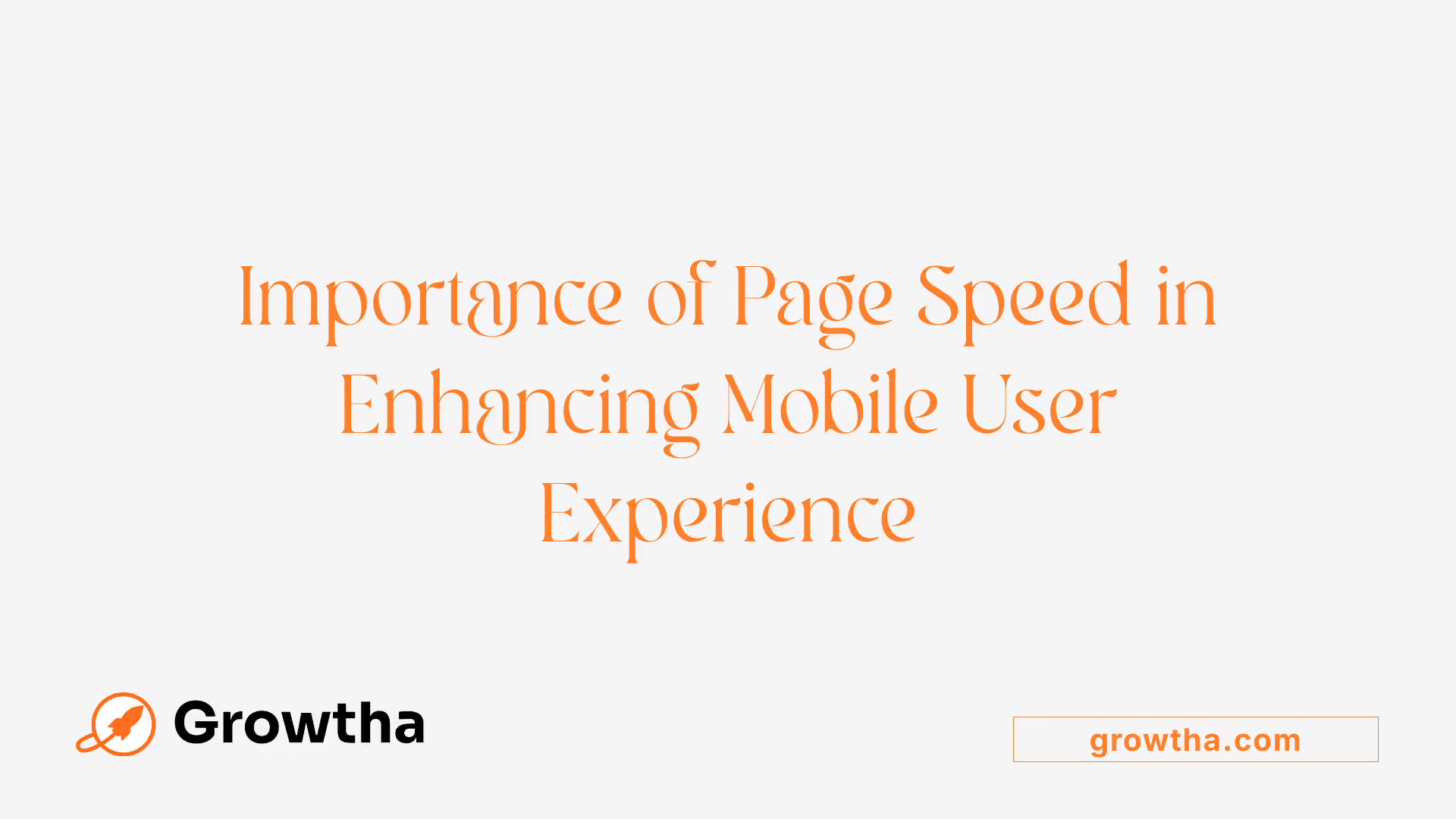Mobile Friendly SEO
This article delves into mobile SEO, emphasizing its significance, best practices, and the technicalities essential for optimizing websites specifically for mobile users.


Mobile Friendly SEO
Harnessing Mobile SEO for Enhanced Digital Visibility
Introduction to Mobile SEO
In today’s digital age, the prevalence of mobile devices has transformed how users interact with the internet, making mobile SEO more crucial than ever. This article delves into mobile SEO, emphasizing its significance, best practices, and the technicalities essential for optimizing websites specifically for mobile users.
Understanding Mobile SEO

What is mobile SEO?
Mobile SEO refers to the optimization of websites specifically for mobile devices, such as smartphones and tablets, due to the significant percentage of internet users accessing the web via these platforms. As over 50% of daily internet traffic comes from mobile devices, Google increasingly favors mobile-friendly sites in search rankings, making mobile SEO essential for visibility. There are three main configurations for mobile websites: responsive web design, dynamic serving, and separate URLs, each with unique implications for SEO. It is crucial to avoid common pitfalls such as slow loading times and faulty redirects, as these can adversely affect user experience and rankings. Given the trend toward mobile-first indexing, businesses must prioritize mobile optimization strategies to prevent potential ranking drops and enhance user engagement.
Importance of mobile SEO
Mobile SEO is critical in the digital landscape, as it ensures that businesses can effectively reach their audience where they are—primarily on mobile devices. More than 60% of organic search visits now come from mobile users, and with increased reliance on smartphones for information and purchases, a well-optimized mobile site often translates to higher engagement and conversion rates. For instance, research demonstrates that 76% of consumers use mobile devices for shopping, indicating that mobile optimization is not just beneficial but essential for appealing to this significant segment of consumers. Also, with Google's mobile-first indexing, prioritizing the mobile experience is vital for maintaining or improving search engine rankings, as non-optimized sites can see dramatic decreases in visibility and user retention.
The Distinction Between Desktop and Mobile SEO
What is the difference between desktop SEO and mobile SEO?
The difference between desktop SEO and mobile SEO lies primarily in how websites are optimized for different devices and user experiences. Mobile SEO prioritizes page speed, mobile usability, and responsive design, as mobile browsing accounts for a significant portion of internet traffic. With Google implementing mobile-first indexing, the search engine ranks sites based on their mobile versions. Mobile users often have immediate needs, leading them to prefer concise information, making site performance critical; slow load times can dramatically increase bounce rates. Moreover, mobile search results typically emphasize rich content such as images and videos, while desktop results tend to provide more text-based information. Ultimately, adapting to mobile SEO is essential for maintaining visibility and competitiveness in search rankings, given the growing predominance of mobile internet usage.
Significance of Mobile SEO

Why is mobile SEO important?
Mobile SEO is important because over 52% of global internet traffic comes from mobile devices, and more than 60% of organic searches occur on mobile. Additionally, Google employs mobile-first indexing, prioritizing the mobile version of websites for ranking. This transition underscores that a lack of mobile optimization can lead to reduced visibility in search results. A well-optimized mobile site enhances user experience with features like fast load times, easy navigation, and readability, which significantly improve user engagement and satisfaction. Furthermore, effective mobile SEO can decrease bounce rates and boost conversion rates, as users are more likely to interact with sites designed for mobile use. As indicated, more than 70% of online traffic now comes from mobile devices, highlighting an urgent need for businesses to implement mobile SEO strategies to remain competitive and meet user expectations.
Traffic Statistics and Indexing Importance
Traffic Type Percentage Significance Global Internet Traffic 59.45% Indicates majority of users connect via mobile. Organic Searches from Mobile 60%+ Reflects the need for mobile-optimized content. Transactions on Mobile Devices 40%+ Shows the importance for e-commerce sites.
Tools for Mobile SEO Optimization

What tools can help with mobile SEO?
Several tools can help with mobile SEO to enhance website performance and search visibility. Google’s Mobile-Friendly Test tool evaluates whether a site is optimized for mobile users. Meanwhile, PageSpeed Insights provides crucial insights on load times and performance, which are essential for improving user experience. For WordPress users, All in One SEO (AIOSEO) is a robust plugin that offers recommendations for mobile optimization starting from the content creation stage. Additionally, Google Search Console can identify mobile usability issues and suggest optimizations. Analytics tools like Google Analytics help track user behavior differences between mobile and desktop usage, allowing businesses to tailor their approaches effectively.
For app-focused strategies, tools such as Sensor Tower and Store Maven are invaluable for app store optimization and keyword research, ultimately supporting wider mobile SEO efforts.
Implementing Mobile-Friendly SEO Tactics

What are some examples of mobile-friendly SEO tactics?
Some examples of mobile-friendly SEO tactics include implementing responsive design, which allows your website to adjust seamlessly to various screen sizes while maintaining a single URL. This approach not only enhances user experience but also prevents issues with duplicate content that can arise with alternate mobile sites. Furthermore, ensuring fast page load speeds is vital; Google recommends that mobile sites load in under one second to boost user engagement and retention. It is essential for businesses to optimize title tags and meta descriptions for mobile viewing to improve click-through rates and visibility in mobile search results. Incorporating structured data also plays a critical role in helping search engines better understand your content, thus improving its presentation in search results. Lastly, it’s imperative to focus on user experience by employing larger fonts, shorter paragraphs, and easily navigable menus, which cater directly to the needs of mobile users.
Considerations for Responsive Design, Structured Data, and Speed
Mobile SEO Tactics Importance Recommendations Responsive Design Adapts to screen size, improves usability Use CSS media queries to ensure layouts adapt on all devices. Structured Data Enhances content visibility in SERPs Implement Schema.org for rich snippets and better indexing. Fast Loading Speeds Reduces bounce rate, increases engagement Aim for loading time of under 1 second; optimize images and minify resources.
Technical Aspects of Mobile SEO
What are the technical aspects of effective mobile SEO?
Technical Aspect Description Importance Responsive Design A design approach that adapts a website's layout to different screen sizes, ensuring usability across devices. Simplifies maintenance and enhances user experience. Structured Data Using schema markup to help search engines understand the content, improving visibility and search results. Can lead to rich snippets, increasing click-through rates. Page Speed Optimization Techniques such as image compression and minimizing JavaScript to improve loading times. Critical, as 53% of users abandon sites that take more than 3 seconds to load.
Consequences of Neglecting Mobile Optimization
Impact on User Engagement
Neglecting mobile optimization can lead to significant consequences for user engagement on your website. When visitors encounter a non-responsive design, they may experience difficulty in reading text, navigating pages, and accessing content, ultimately leading to frustration. Statistics reveal that over 62% of users are less likely to purchase from a business after a negative mobile experience, while 74% are more likely to return to a mobile-friendly site. This emphasizes the vital role that a mobile-optimized design plays in enhancing user satisfaction and retention.
Search Engine Rankings
The search engine landscape has evolved dramatically with Google implementing its mobile-first indexing approach. Websites without mobile optimization can see their visibility drastically reduced, as Google prioritizes mobile-friendly sites in search results. This can result in lower rankings and diminished organic traffic. In fact, over 60% of all web traffic now comes from mobile devices. Therefore, failing to optimize for mobile not only disappoints users but also risks relegating your site to obscurity in search results, further exacerbating the struggle to attract visitors.
The Rise of Mobile Searches and User Behavior
How have mobile searches changed consumer behavior?
Mobile searches have significantly outpaced desktop searches, reflecting a transformative shift in how consumers engage with the digital marketplace. The statistics are telling: searches for product reviews have surged by 35%, while inquiries for 'best' products have skyrocketed by 80%. This trend underscores a critical reliance on mobile devices for instant information, influencing purchasing decisions in real time. As a result, mobile has become the go-to platform not only for research but also for shopping. The emphasis on swift access to information means that businesses must prioritize mobile-friendly websites. In an environment where over 60% of organic search visits stem from mobile devices, neglecting mobile optimization might lead to missing out on potential customers, ultimately affecting conversion rates and brand loyalty. Responsive design, fast page loading speeds, and engaging content tailored for mobile users are now imperative for capitalizing on this mobile-driven consumer behavior.
Google's Shift to Mobile-First Indexing
What is mobile-first indexing and why is it crucial?
Mobile-first indexing refers to Google's focus on the mobile version of websites when evaluating their rankings in search engine results. This adjustment is vital as it underscores the increasing prevalence of mobile browsing—over 60% of searches are now performed on mobile devices. Website owners must prioritize mobile optimization to adapt to this shift; if a site's mobile version is not well-designed, the business risks a significant drop in search rankings and online visibility. As mobile users expect fast loading speeds, easy navigation, and visually appealing layouts, websites need to ensure an experience tailored for mobile use. Google’s criteria for indexing and ranking now emphasize how effective websites are on mobile devices, making it more critical than ever for businesses to align their digital strategies to meet these standards.
Responsive Design: The Cornerstone of Mobile SEO
Why is responsive design recommended for mobile SEO?
Responsive design is highly recommended for mobile SEO as it allows a website to adapt effectively to any screen size, providing a seamless user experience across different devices. By maintaining a single URL, it simplifies Google's indexing process and avoids issues related to duplicate content. This approach enhances user experience by ensuring content is readable and navigable, and it aligns with Google's preference for mobile optimization, helping improve search rankings.
Benefits Impact on SEO User Experience Single URL structure Simplifies indexing process, reduces duplicate content issues Provides a consistent experience across devices Improved load times Boosts search rankings due to speed being a ranking factor Enhances user satisfaction by reducing wait times Streamlined navigation Encourages higher user retention, leading to lower bounce rates Allows users to easily find and engage with content
Ensuring Mobile Page Speed

How does page speed affect mobile SEO?
Page speed is a critical factor in mobile SEO as it directly influences user engagement and search rankings. Google prioritizes fast-loading mobile pages, recommending a load time of under one second. This benchmark reflects the user's expectation for quick accessibility to content, particularly on mobile devices where connectivity can be variable. Slow-loading pages can lead to user frustration and high bounce rates, with studies showing that most users abandon a site that takes more than three seconds to load. The repercussions of lagging load speeds extend beyond user experience; they can drastically impact conversion rates and search visibility. Businesses can enhance page speed through various optimization techniques, such as image compression, code minification, and reducing server response times. These practices not only help retain users but also facilitate smoother interactions, which are essential for maintaining competitiveness in the increasingly digital marketplace.
The Impact on User Retention
The importance of quick loading times cannot be overstated when it comes to user retention. Visitors are significantly more likely to return to a website that performs well on mobile. Research shows that 74% of users are more inclined to revisit a mobile-friendly site, noting that a satisfying experience encourages repeat visits. This retention is further linked to the overall health of the site’s traffic, as returning users typically engage for longer periods. In an age where 70% of internet time is spent on mobile, ensuring that sites load swiftly and efficiently is not just a preference—it's a necessity. Users expect immediate access to information, and any delays can result in not only lost traffic but also a diminished perception of the brand. Overall, optimizing page speed is tantamount to fostering customer loyalty and improving the likelihood of conversions.
Optimization Method Description Impact on Speed Image Optimization Compressing images for quicker load times Reduces file size, enhancing loading speed Code Minification Removing unnecessary characters from code Streamlines loading process, boosts performance Reducing Server Response Time Enhancing server efficiency and processing Expedites page loading, improves user satisfaction
Crafting Content for Mobile Consumption
How should content be tailored for mobile users?
Content for mobile users should be concise and structured for easy readability on smaller screens. This involves using larger font sizes, minimal scrolling, and shorter paragraphs to ensure users can quickly absorb information. Employing structured data can enhance content visibility in search results, while focusing on clear, direct language helps maintain user engagement and interaction. Optimizing content in this manner not only improves user experience but also fosters higher retention rates, ultimately boosting mobile SEO. Effective mobile content creation ensures that visitors can digest information without frustration, promoting a smoother navigation experience and keeping users returning to the site.
Topic Recommendation Impact Concise Content Use shorter paragraphs and bullet points to present information clearly. Enhances readability and keeps users engaged. Readability Larger font sizes and ample white space for text. Improves the visual experience, reducing eye strain. User Engagement Integrate structured data and interactive elements. Encourages user interactivity and potential conversions.
Utilizing Tools for Mobile Usability Assessment
What tools can assess mobile usability effectively?
Tool Name Purpose Key Insights Google's Mobile-Friendly Test Evaluates site for mobile-friendliness Checks viewport settings, recommends font sizes, and assesses tap target sizes. Google Search Console Monitors overall site health on mobile Identifies mobile usability issues and provides actionable reports. Google Lighthouse Analyzes performance and accessibility Offers detailed insights on page speed and user experience.
Embracing Mobile SEO for Future Success
In conclusion, mobile SEO represents a vital component of modern digital marketing strategies. With the ever-increasing shift towards mobile internet usage, optimizing for mobile devices is no longer optional but a necessity. By understanding and implementing best practices in mobile SEO, such as enhancing page speed, using responsive designs, and crafting mobile-specific content, businesses can significantly improve their search rankings and user engagement. Leveraging the right tools to continuously assess and refine mobile usability ensures that your website not only meets but exceeds the expectations of today’s mobile-first world. As technology keeps evolving, staying ahead of mobile SEO trends will be crucial in maintaining competitiveness in the digital marketplace.
References
- The DIY Mobile SEO Guide: How to Be Mobile-First in 2024
- The Complete Guide to Mobile SEO: 8 Tips & Best Practices - Semrush
- How to improve your mobile site? • SEO for beginners - Yoast
- Mobile SEO: The Definitive Guide - Backlinko
- How to Make Your Site Mobile Friendly for SEO - WooRank
- Your Mobile SEO Guide: 9 Ways to Optimize for Mobile-Friendly SEO
- An In-Depth Guide And Best Practices For Mobile SEO







